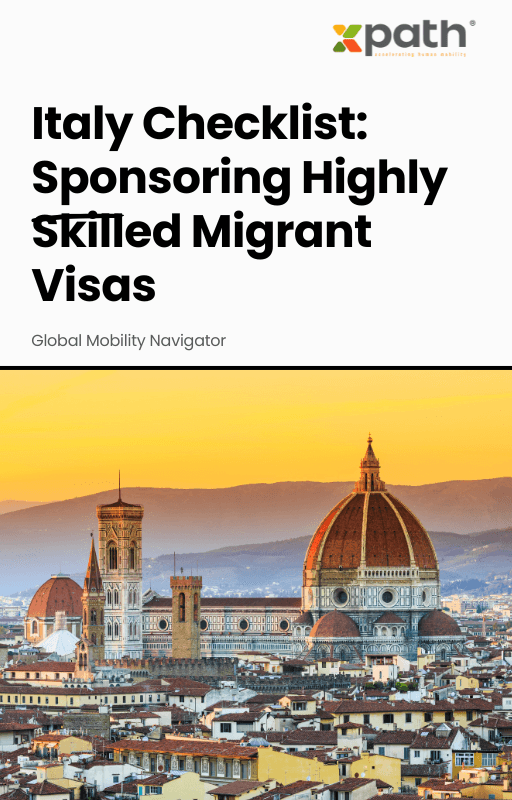Italy Checklist: Sponsoring Highly Skilled Migrant Visas
Grab a copy of a guide to international employee relocation
View E-bookPayroll costs aren’t just about salaries. There are contributions for social security, health care, pension plans, and taxes that can vary wildly—not just from country to country, but sometimes from city to city. According to a 2023 Deloitte report, payroll expenses can account for up to 70% of total business costs for multinational enterprises, with compliance-related costs growing by 15% year over year. That means even a minor misstep can be a pricey error, both in dollars and potential legal trouble.
On top of these hefty costs, companies must contend with a kaleidoscope of employment laws. For example, the European Union’s Working Time Directive creates strict rules about maximum working hours, paid leave, and overtime. The United States’ FLSA asks employers to classify workers correctly for overtime. Add to that the specifics of local tax filings, mandatory benefits, and ever-changing labor laws, and you’ve got a situation ripe for confusion—and financial risk.
It’s not just anecdotal—data shows just how complicated payroll and compliance have become for global businesses. In a 2024 PwC global mobility survey, 68% of organizations cited payroll compliance as one of their top challenges. Meanwhile, as many as 40% of multinationals reported facing fines or audits due to errors in international payroll reporting.
The cost of getting it wrong can be staggering. The EY Global Payroll Survey found that penalties for noncompliance ranged from thousands to millions of dollars. Companies operating in 10+ countries spend, on average, 27% more on payroll administration than those operating in just one.
Case in point: a US-based tech firm expanding to Germany underestimated local employer contributions and was fined over €100,000 for back payments and noncompliance. This example isn’t rare—it’s a warning shot for businesses expanding globally without the right support.
The real trouble starts when local employment rules collide with corporate global policies. Multinationals must navigate differences in:
Each of these areas is a potential compliance pitfall if not handled with expertise. HR teams are left juggling compliance updates from hundreds of authorities—all while ensuring the right employees are paid the right amounts, on time, every time.
What’s more, the push for remote and hybrid work has thrown extra curveballs at the situation, making the old model of ‘one country, one payroll system’ deeply outdated. For example, a single remote worker in Singapore could require company-wide updates to payroll systems, reporting structures, and benefits allocation.
So how do successful global organizations manage these headaches? The answer: strategic global mobility solutions paired with expert partners. Take, for instance, a global pharmaceutical giant with operations on five continents. By centralizing their payroll processes and leveraging partner platforms like xpath.global, they reduced payroll errors by 45% and slashed noncompliance fines by 60% within a year.
Xpath.global specializes in streamlining global employment workflows. By automating compliance checks, consolidating payroll data, and providing on-demand expertise in 190+ countries, they give companies the tools to confidently expand—minus the usual payroll panic. Businesses using xpath.global report:
IBM’s global mobility program, cited in a 2023 PwC case study, used digital solutions to centralize payroll and automate compliance updates, leading to annual savings of over $3 million and a 70% reduction in compliance incidents.
Digital transformation isn’t just a buzzword—it’s a lifeline for HR teams stretched thin by global complexity. Modern mobility platforms break down silos between payroll, compliance, HR, and finance by uniting all moving parts in one dashboard. Artificial intelligence and machine learning are making it easier to predict cost overruns, detect compliance risks, and automate routine payroll tasks.
According to KPMG, 59% of global enterprises plan to further digitize their HR and payroll systems by 2025, citing cost savings, transparency, and ease of scaling as top motivators. With the right mobility solution—like those offered by xpath.global—companies can turn payroll headaches into streamlined, repeatable processes that support growth, not bog it down.
Managing global payroll costs and complex employment rules isn’t just an HR problem—it’s a business risk and a growth opportunity. The right global mobility solution can help you sidestep expensive pitfalls, stay on the right side of the law, and free your team to focus on what matters most: building a world-class organization. Whether you’re entering new markets or scaling up remote teams, digital tools and expert partners like xpath.global make the journey smoother. Why gamble with compliance and payroll chaos when smarter, simpler solutions are within reach?
Q: What are the main drivers of high global payroll costs?
A: Salary and benefits are the largest components, but hidden costs like employer contributions, local tax compliance, payroll processing fees, and penalties for noncompliance all contribute. Regional differences in employment law add complexity and cost too.
Q: How can companies ensure compliance with employment rules in multiple countries?
A: Companies should stay proactive by automated compliance tracking, regular audits, working with local experts, and leveraging digital mobility platforms like xpath.global that centralize rule updates and streamline payroll processes.
Q: What are the risks if companies fail to comply with employment regulations?
A: Beyond hefty fines, companies risk damaged reputation, restricted market access, employee dissatisfaction, and even legal action. The best insurance is investing in robust, automated global payroll and compliance solutions.
Q: Can a digital global mobility solution really save my company money?
A: Absolutely. By reducing manual work, minimizing errors, speeding up onboarding, and avoiding costly noncompliance penalties, solutions like xpath.global help companies get more out of their global workforce budgets.
Ready to transform your mobility program? Explore xpath.global’s solutions.

Italy Checklist: Sponsoring Highly Skilled Migrant Visas
Grab a copy of a guide to international employee relocation
View E-book